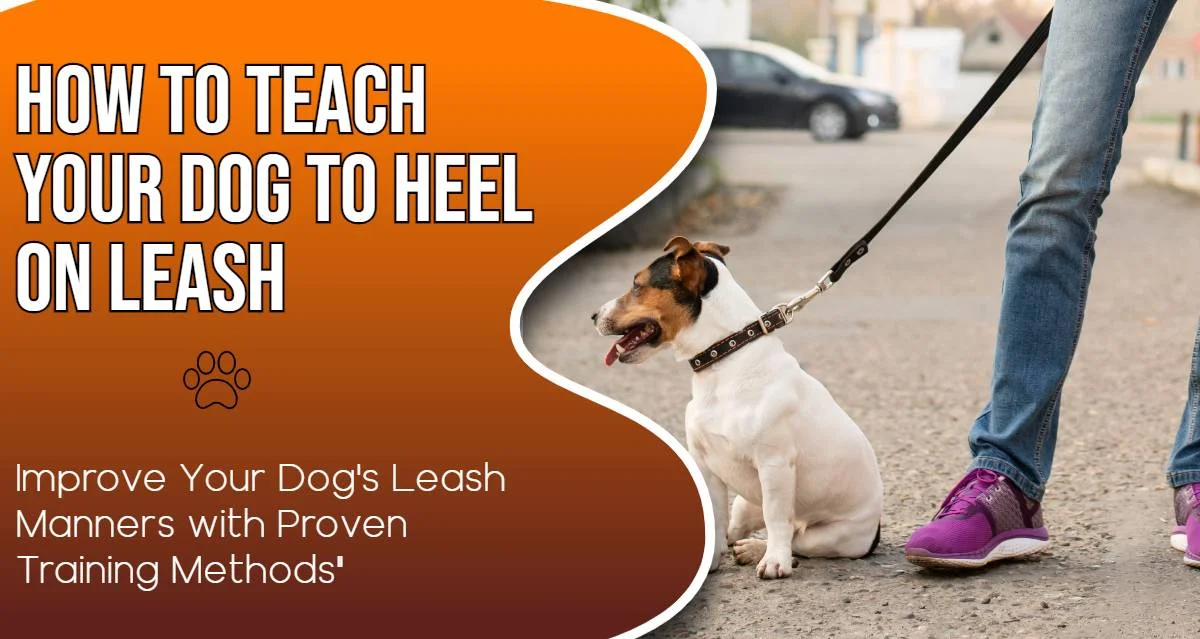Imagine you’re out for a leisurely walk with your furry companion, but instead of walking by your side like a well-behaved pooch, they start doing their best impersonation of a sled dog in the Iditarod.
It’s like they’ve mistaken you for Santa Claus and are determined to deliver presents at lightning speed.
In this article, “How to Teach a Dog to Heel on Leash,” we’ll explore various techniques and strategies to help you achieve that perfect walking companion. Patience is the key part of it because teaching a dog to heel can be quite a challenge. With a little patience and consistency, you’ll have your pup walking right by your side.
What is the “Heel” command?
Let’s first know what the “Heel” command really is. When you give the “heel” command, your pup should position themselves on your left side (well, you can choose the right side as well. It’s up to you) and match your pace as you walk. They shouldn’t be pulling ahead or lagging behind, but rather staying in sync with you.
Why is it Necessary to Teach This Command?

You may have noticed that whenever you get to know about certain strategies for training your dog to either stop pulling, calm down, reduce their reactive energy or relevant things, the first thing that everyone usually emphasizes is to ensure that our puppy is trained to respond well to the basic commands.
The “heel command” comes under the basic commands that form the basis for the puppy’s behavior even in his adult life. That being said, it leads to the following points proving its importance.
Safety
When your puppy learns to heel, it means he’ll stay close to you during walks, right? And that’s super important because it helps prevent any potential accidents or mishaps.
Imagine your pup darting off in excitement, dragging you along behind him like a ragdoll. Not cool, right? By teaching them to heel, you’re ensuring his safety as well as your own. It’s a great way to establish control and keep him out of harm’s way.
Focus
A puppy who knows how to heel will pay attention to you and follow your lead. It’ll improve his focus when it comes to training him in the future as well.
Imagine if he were constantly distracted, sniffing every tree or chasing after squirrels while you’re trying to walk together. Chaos, right? By teaching him to focus on you and stay by your side, you’re ensuring a smoother and more controlled walking experience.
Socialization
When your little buddy learns to heel, it opens up a world of opportunities for socialization. By keeping him close to you during walks, you can gradually introduce him to other dogs and people in a controlled and safe manner.
This helps him build confidence, learn proper behavior, and develop positive interactions with others. When he’s well-socialized, it makes outings and adventures much more enjoyable for both of you.
When Your Dog Is Ready to Heel on a Leash?

A puppy goes through three phases—the primary phase, the socialization phase, and the improvement phase—before they finally step into adulthood. These three phases have great importance when it comes to training the puppy and his attitude in adulthood.
The socialization phase, among these three phases, plays quite a great part. This is because it starts from 8 weeks and lasts till about 14 weeks. During this time, the puppy is highly aware of his environment and is susceptible to whatever learning patterns he’s subjected to. It has a great impact on the behavior he displays in the future as well. Hence, it is a critical phase when it comes to his training as well.
You can start the leash training at 8 weeks. It’s good to start teaching them the basic commands like a heel at approximately 10 weeks. From here, you can gradually increase the training process.
8 Steps to Teach Your Dog to Heel on Leash
Now, let’s see how you can effectively teach his command to your pup on a leash. We’re going to go through the following steps one by one:
- Start in a quiet environment.
- See if he’s ready to heel on a leash.
- Take a lot of treats with you.
- When your pup starts to walk behind you or ahead of you, take this step.
- When you get to grab their attention, follow this step.
- Utter the command heel when they settle at your left side.
- Stay consistent throughout the process.
- Gradually practice in crowded areas.
1. Start in a Quiet Environment.
When it comes to teaching a pup the heel command on a leash, it’s best to start in a familiar, comfortable, and quiet place, like your backyard or a quiet park.
This way, your furry friend can focus on learning without being overwhelmed by new surroundings.
Once they get the hang of it, you can venture out to busier areas and practice their healing skills in different environments.
2. See if He is Ready to Heel on a Leash
When you attach the leash to your puppy’s collar, and he starts biting the leash or shows negative behavior, don’t start with the training. In this case, you need to show him how to calm down. If he’s overly excited, engage him in some exercises before you train him. Ensure that the exercise doesn’t end up making him tired, otherwise, he won’t be able to focus on the training.
3. Take a lot of Treats With You
When it comes to teaching your dog how to heel on a leash, having plenty of treats is like having a secret weapon in your pocket.
You see, dogs are motivated by food. So, by using treats as rewards during training, you’re giving them something they really want.
When it comes to treats, you want to use something healthy and tasty that will motivate your pup. Some good options include pieces of chicken, cooked turkey, small bites of cheese, or even dog-specific training treats like liverwurst or hot dogs. Just make sure to avoid giving your dog too many table scraps or junk food, as these can lead to weight gain and other health issues.
Studies shows the positive impact of treats and in dog training, including reward-based techniques to reinforce desired behaviors like heeling
This positive reinforcement helps them associate good behavior with yummy rewards, making the training process more enjoyable and effective.
4. When Your Pup Starts to Walk Behind You or Ahead of you, do this:
Take a handful of treats and keep them in your left hand (in case you want your dog to walk on your left side). When your pup starts to walk ahead or lag behind, grab his attention by showing him the yummy treats. Allow him to sniff the treats.
5. When you’re able to Grab Their Attention, Do this
As they draw nearer, extend your arm and give them a gentle nudge, playfully guiding them in a circular motion or by giving a slight wiggle, making it all fun and light-hearted. They will do this as they’re after getting the tasty treat.
6. Utter the Command “heel” When They Settle at Your Left Side
Once your pup has come at your left side, it’s time to give them the command. Use a very clear and precise tone when you say “heel”. Ensure that your voice carries clarity and assurance.
This step strengthens the association between verbal cues and the desired action. It leads to the foundation of proficient heel command to be executed effectively.
7. Stay Consistent Throughout The Process
Consistency is key when it comes to training our furry friends to heel on a leash as it’s not as easy as it looks.
Dogs thrive on routine and repetition. By staying consistent in our training methods and expectations, we create a clear and predictable environment for them. This helps them understand what behavior is expected of them and reinforces the desired action of heeling on a leash.
Therefore, practice this technique every day with your pup.
If we’re inconsistent or constantly changing our approach, it can confuse our pups and make it harder for them to grasp the concept.
So, by being consistent, we’re setting them up for success and making the training process smoother and more effective. Plus, it’s a great way to strengthen the bond between us and our four-legged pals.
8. Gradually Practice in Crowded Areas
As we’ve advised, start practicing in quieter areas first, like your backyard or a park with fewer distractions. Once your furry friend gets the hang of it, you can gradually move on to more crowded places.
This is because it’s crucial for your furry friend to learn how to behave on a leash amidst distractions like people, other dogs, and all the hustle and bustle of the outside world.
Remember, patience is key here. It might take some time for your pup to master the heel command in crowded areas. But with consistent practice and lots of love, they’ll get there.
Final Thoughts
Congratulations on completing this comprehensive guide on teaching your pup to heel on a leash. By following these steps, you’re well on your way to having a well-behaved and obedient furry companion.
Remember, the key is to start in controlled environments, gradually introducing distractions and increasing difficulty. Use positive reinforcement techniques like treats, praise, and affection to reward your pup for walking calmly by your side.
Consistency is key, so make sure to practice regularly and be patient with your pup’s progress. As you venture into busier areas, such as parks or city streets, continue reinforcing the heeling command and providing positive reinforcement.
Soon enough, your pup will master the art of walking politely on a leash, making your walks a joyous experience for both of you.

Dr. Haider is a general doctor with a unique level of connection to our four-legged friends. He is a valued contributor to our Website (Leash and Lope). Dedicated to providing accurate to dog owners in understanding and caring for their lovely pets.

